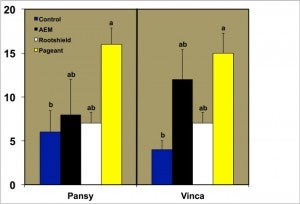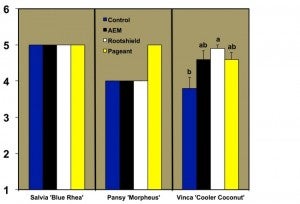Biological Control of Root Rots in Bedding Plants — Commercial Greenhouse Trial
An important part of the Parrella lab IPM program is evaluating new products and strategies at commercial greenhouses. This trial was an evaluation of root rot control in bedding plants that I conducted at a greenhouse on California’s Central Coast. We compared biological products with a traditional fungicide. The biocontrols were RootShield (Trichoderma harzianum; BioWorks) and Activated Effective Microorganisms (AEM) (a mix of several beneficial microbes; TeraGanix); the conventional product was Pageant (pyraclostrobin and boscalid; BASF). RootShield and Pageant are labeled as fungicides, while AEM is a plant health promoter. It stimulates root growth and suppresses some pathogens; our work has shown that these two actions provide partial management of root rots.
We also tracked populations of fungus gnats, shoreflies, and moth flies as these insects can spread plant diseases in the greenhouse.
Methods
Seeds of salvia (Salvia farinacea ‘Blue Rhea’), pansy (Viola x wittrockiana ‘Morpheus’) and vinca (Catharanthus roseus ‘Coconut Cooler’) were sown the week of August 15; data was taken on September 1 and September 21.
Plants were evaluated two and five weeks after sowing to evaluate the percent loss per flat (visual estimate; includes both dead plants and ungerminated seed) and overall flat quality (1 to 5, with 1= all dead to 5 = all healthy). Yellow sticky cards were placed on August 31 (one card per treatment) and were counted on September 1 and September 21.
There were five replications of four treatments: AEM (1:500 dilution with weekly applications), RootShield (4 oz per 100 gallons with weekly applications), Pageant (12 oz per 100 gallons applied as per label directions), and an untreated control.
Results
At week 2, crop loss was significantly different from the contol in the Pageant treatment (Fig. 1). We suspect this was due to phytotoxicity. By week 5 there was no crop quality difference between treatments in either the salvia or the pansy. Vinca at week 5 had no difference in quality between the three disease management tactics, although the RootShield treatment was significantly different from the control (Fig. 2).

Figure 1. Mean percent loss per flat by treatment two weeks after sowing. Columns within a plant species with different letters are significantly different. Treatment effect was tested using ANOVA and means separation was done with Tukey’s test. The vinca data was log10 transformed to meet the assumptions of ANOVA; untransformed data is presented. Pansy: df=3,19; F=4.1833; p=0.0230. Vinca: df=3,

Figure 2. Mean flat quality by treatment five weeks after sowing. Columns within a plant species with different letters are significantly different. Treatment effect was tested using ANOVA and means separation was done with Tukey’s test. Vinca: df=3,19; F=4.5641; p=0.0171.
Fungus gnats, shore flies, and moth flies are an on-going concern at this greenhouse’s cool, damp coastal location. During this trial fungus gnat and moth fly populations were very low (1-2 per card per week); moderate shore fly levels of 10-15 per card per week were observed.
Conclusions
All three treatments provided excellent crop quality with relative low plant loss. The grower’s attention to sanitation and insect disease vector management explains the low disease pressure as evidenced by the lack of crop loss or poor quality in the control.
- Posted by
 cacasey
cacasey - Posted in Biofungicides, Biological control
 Feb, 11, 2015
Feb, 11, 2015 Comments Off on Biological Control of Root Rots in Bedding Plants — Commercial Greenhouse Trial
Comments Off on Biological Control of Root Rots in Bedding Plants — Commercial Greenhouse Trial
 (530) 752-4784
(530) 752-4784 Join Us On Facebook
Join Us On Facebook Join Us On Twitter
Join Us On Twitter Join Us On In.com
Join Us On In.com Subscribe to RSS
Subscribe to RSS Follow Us On Google+
Follow Us On Google+ Subscribe Us On Youtube
Subscribe Us On Youtube Follow Us On Pinterest
Follow Us On Pinterest Follow Us On Instagram
Follow Us On Instagram Follow Us On Tumblr
Follow Us On Tumblr Subscribe Us On Flickr
Subscribe Us On Flickr